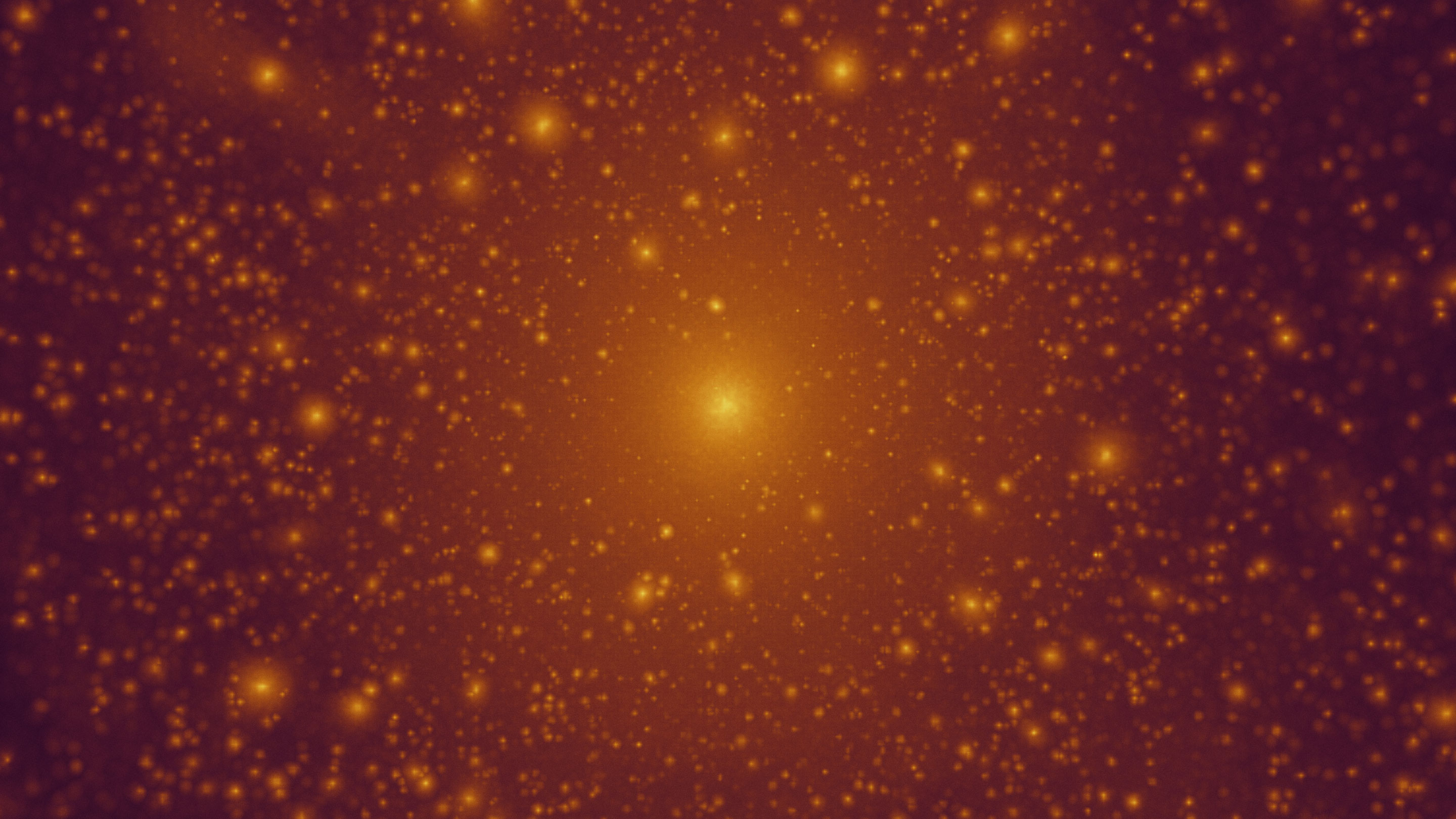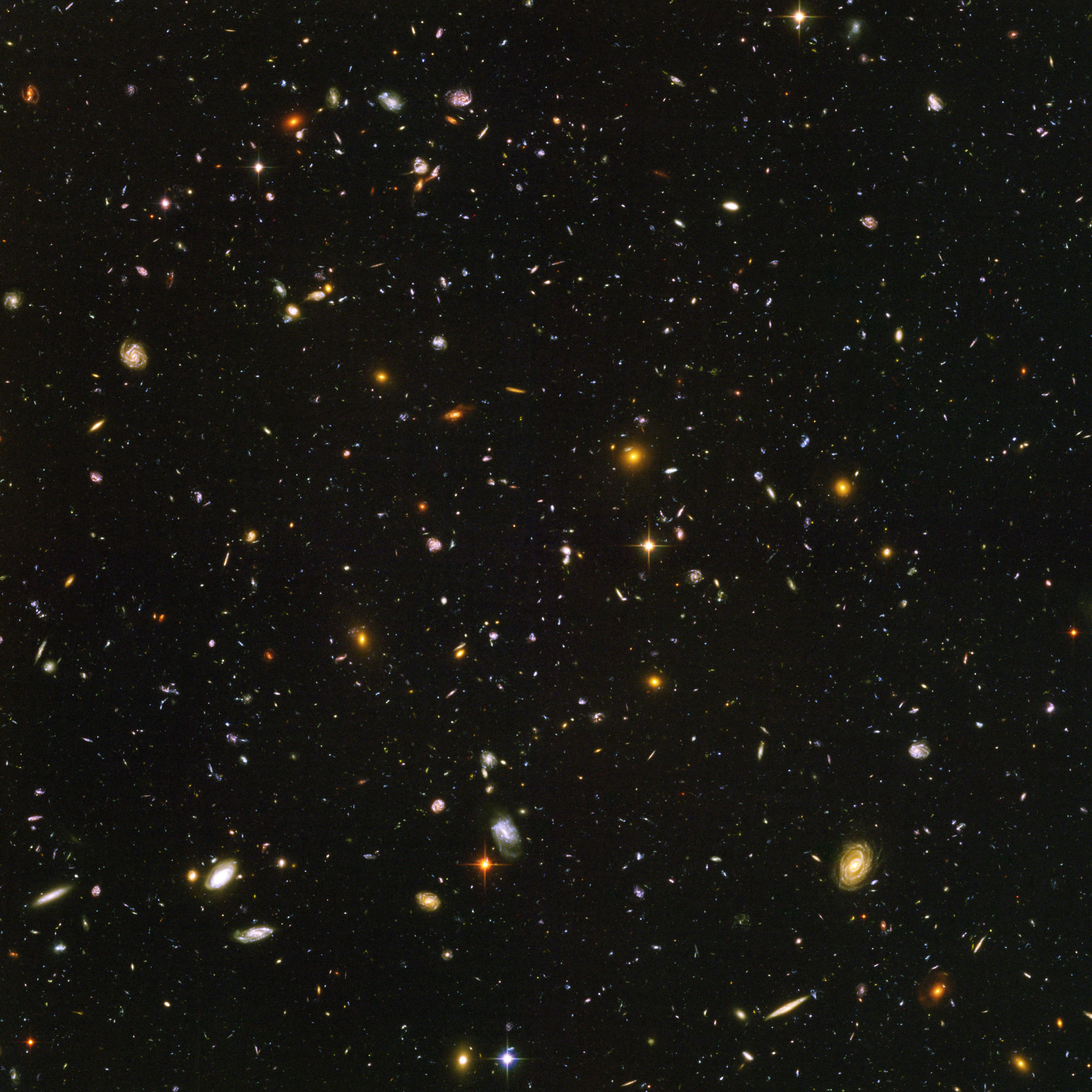Missing Galaxies? Now There’s Too Many

This simulation of the dark matter in a galactic halo shows the presence of many dark matter clumps. Astronomers want to know how massive each clump has to be in order to attract enough ordinary matter to form a dwarf galaxy.
Introduction
Gaze skyward from the Southern Hemisphere and it’s hard to miss the Large Magellanic Cloud. The fact that it looks like one of the Milky Way’s spiral arms, albeit smaller, reveals that it’s a small galaxy roughly 30,000 light-years across with a few billion stars. Indeed, any small telescope will show that it’s scattered with glowing nebulae that are punctured by dark dollops of dust.
And it isn’t the only satellite galaxy that slowly swirls around the Milky Way. By 1999, astronomers had detected a dozen companions, many of them invisible to the unaided eye. But at that time, computer simulations of the evolution of the universe had predicted that the Milky Way’s neighborhood should be bustling with activity — hosting not a dozen, but thousands, of tiny companions. So where were the missing satellites?
That astronomical riddle went on to bedevil astronomers for nearly two decades. Researchers came up with a number of potential explanations. Some involved speculative new ideas about how galaxies evolve. Others proposed the existence of exotic forms of dark matter — the mysterious substance that makes up 84 percent of the matter in the universe.
But within the past few years something strange happened. New surveys allowed astronomers to find more satellite galaxies that had previously been hidden. At the same time, updated computer simulations predicted the existence of far fewer galaxies than their predecessors did.
In fact, the estimates of galaxy numbers from observational studies and from theoretical simulations converged so quickly that they ended up overshooting each other. Whereas in the early 2000s astronomers worried that there were too few satellites, by 2018 there appeared to be too many. The missing satellites problem had been turned inside out.
Yet now some astronomers see a potential solution. Paradoxically, solving the glut of satellites might mean postulating that there might be even more satellites than previously thought — so long as they’re extremely small.
A New Kind of Galaxy
Astronomers took the first step toward resolving the missing satellites problem in 2004. That’s when Beth Willman, at the time a postdoc at New York University, found herself staring at a dark image on a colleague’s computer screen that was sprinkled with red, orange and blue foreground stars from the Milky Way and a faint smudge in the center. At least she thought there was a smudge in the center. She worried that it was simply an artifact created by her imagination.
If that smudge turned out to be an actual physical object, it could be an ultrafaint dwarf galaxy — something only 1 percent as luminous as the puniest galaxies known to exist at that time.
But that seemed impossible. Only two years earlier, astronomers had begun to make the argument for why no more dwarf galaxies were waiting to be discovered. In addition, it seemed far-fetched to think that such a feeble object could hold on to the gas necessary to spark star formation. “I was very hesitant to interpret it,” Willman recalled. “I thought, ‘These objects, they can’t really exist. They look so wimpy.’”
But it turned out to be real. Willman’s discovery of the first ultrafaint dwarf galaxy made clear that the Milky Way’s outer fringes were hiding more secrets.
In time, the Sloan Digital Sky Survey and the Dark Energy Survey helped increase the count of known satellite galaxies to more than 50. Many were similar to the object Willman had discovered — ultrafaint dwarf galaxies that could be so small they might only host a thousand stars.
But even these surveys did not cover the entire sky. Nor could they pinpoint every dwarf galaxy within the Milky Way’s neighborhood. Some are simply so faint that they’re no longer visible past a certain distance.
In 2008, a string of papers were published that took into account these detectability limits in an attempt to make more-accurate predictions about the numbers of dwarf galaxies crowding the Milky Way. Those statistics were alarming. Erik Tollerud, an astronomer at the Space Telescope Science Institute, and his colleagues estimated that there might be as many as a thousand invisible dwarf galaxies — a number much larger than the dozen dwarfs known when the missing satellites problem started.
“There’s this perception now that there is this whole population of very tiny galaxies lurking out there — but we can’t see them,” said James Bullock, an astronomer at the University of California, Irvine. “They’re these little ghost galaxies.”
Meanwhile, researchers including Bullock have been running new computer simulations of galaxy formation. They’ve found that a large galaxy like the Milky Way should be eating these ghosts over the course of cosmic time. As Annika Peter, an astronomer at Ohio State University, puts it: “The Milky Way is a lot like the Cookie Monster.”
Better Cosmic Models
Early computer simulations of the history of the universe — the ones that predicted that there should be many thousands of galaxies orbiting the Milky Way — had a major limitation: They included only dark matter.
The simulations were dark for two reasons. The first is that simulating the 14-billion-year history of the universe in all its complexity is downright impossible. Yet if you model only dark matter, it becomes feasible. That’s because dark matter is relatively simple, interacting only (so far as we know) via gravity. Ordinary matter, by contrast, interacts in a number of ways. Stars, for example, can explode catastrophically. These explosions release energy into the cosmos that heats the surrounding gas. They also seed the universe with heavier elements that fuel the next generation of stars.
These details, researchers thought, could be overlooked. And indeed, dark-matter-only simulations did a remarkable job of re-creating the large-scale cosmic structure of the universe. Which brings us to the second reason: Dark matter is responsible for the layout of the cosmos.
Dark matter provides the scaffolding that supports the galaxies sprinkled throughout our universe. Take the Milky Way as an example. Our galaxy is embedded within a massive dark matter cloud, or halo, that extends far beyond the iconic spiral disk. Cosmologists believe that the halo formed first. In time, the gravitational pull from this dark halo attracted all the ordinary matter that forms the swirling disk of dust and stars that we think of when we think “Milky Way.”
In addition, this halo contains a number of mini-halos that themselves formed the cosmic scaffolding for satellite galaxies such as the Large and Small Magellanic clouds. Because of this, a dark simulation is actually a fairly good approximation for the visible matter within the universe.
Good, but not perfect. As astronomers gained better access to computing facilities, as engineers built faster processors and as scientists started to better understand the physical processes surrounding normal matter (like the merciless effects of stellar explosions), they began to gain the tools necessary for complex simulations that included normal matter.
In 2016, Andrew Wetzel of the University of California, Davis, and his colleagues created one of the first lifelike simulations of a central massive galaxy and its legion of dwarfs. It looked nothing like previous dark models. In Wetzel’s model, the central galaxy destroyed so many dwarfs that only 13 remained after the 14-billion-year run. Whereas previously dwarf galaxies existed in abundance, now they were scarcely there.
Astronomers set out to understand why. A second paper published by Wetzel along with Shea Garrison-Kimmel, an astronomer at the California Institute of Technology, and colleagues in mid-2017 compared simulations that had normal matter with those that did not. They found that in simulations with normal matter, the extra bulk in the galactic disk gives the central galaxy a much stronger gravitational field. And that makes all the difference. Without it, the dwarfs plunge in and out of the Milky Way, escaping without a scratch. But with normal matter, the disk tears them to shreds.
The work further reduced the number of dwarfs predicted by models. It also, paradoxically, went on to increase the number of dwarfs that astronomers think are lurking out in the fringes of the Milky Way.
Simulating the Milky Way
Garrison-Kimmel and his colleagues argued that the Milky Way’s disk is ravenous, feeding on dwarfs, but that it munches only on the galaxies that are close to the disk. “It’s going to eat all the cookies in the house, but probably not walk to the bakery to eat the ones out there,” said Peter.
Because of that, we should expect to find relatively few dwarf galaxies close to the Milky Way’s disk, with far more galaxies lingering toward the outer edges of the Milky Way’s halo — well beyond what we can see. When Peter and her colleagues took this into account, they estimated that there are likely anywhere between 800 and 1,700 satellites just beyond the limit that our best observatories can detect. But when the team simulated how many satellites should have formed in the early universe, they found that those numbers were far lower, at 100 to 300.
And a November study by Bullock and his colleagues suggests the problem might be even starker. Unlike previous simulations, which simply focused on nondescript galaxies that were the approximate size of the Milky Way, this new simulation attempts to model the Milky Way itself. Bullock’s team created a number of simulations (all named after different Elvis Presley songs) that ran the gamut for their best estimates of the Milky Way’s mass, structure and evolution.
Those simulations concluded that our Milky Way is quite the Cookie Monster. Only 30 satellite galaxies should have survived to the present day. That’s fewer than the numbers astronomers have already found.
Both studies show that researchers have the opposite problem than they did 20 years ago: Thousands of galaxies appear to be swarming around the Milky Way, but simulations only predict dozens. “It creates this interesting tension — it has flipped the model on its head,” Bullock said.
Small Enough to Form a Galaxy
But Bullock and his colleagues didn’t merely outline the problem, they also proposed a solution. Simulations have long suggested that lots of dark-matter mini-halos formed around the Milky Way. But astronomers argued that these halos didn’t form galaxies. There’s a threshold, the argument went, below which these halos simply didn’t have enough gravity to hold on to the gas necessary to form stars. They were thus star-free and invisible.
For nearly 20 years, astronomers thought that threshold for the mass of a dark-matter halo that could form a galaxy rested around 500 million times the mass of the sun. But Bullock’s team suspects that it’s much lower, around 30 million times the mass of the sun.
If such small globs of dark matter can grab onto enough ordinary matter to create stars (and thus galaxies), then simulations start to match observations. Indeed, Bullock’s team was able to model galaxies that are eerily real. Not only do the numbers of simulated mini-halos match the numbers that are predicted by observations, but the shapes of the galaxies’ orbits even look like the ones we have already detected. “I thought I messed up when I made that plot and they matched up so closely,” said Tyler Kelley, a graduate student at Irvine who led the study.

Although it’s a puzzle as to how these mini-halos form dwarf galaxies that are much smaller than previously thought, they’ll likely help astronomers understand the nature of dark matter.
Most cosmologists believe that dark-matter particles are “cold,” meaning that they move slowly. Because of this, they can coalesce into numerous tiny halos, providing scores of places where dwarf galaxies can form. But “warm” or “hot” dark matter, which by definition moves faster, cannot coalesce so easily. In fact, hot particles wouldn’t be able to form mini-halos at all. So the sheer existence of these small galaxies is a sign that warm dark matter is likely not at play. “It’s very bad news for alternative dark-matter scenarios,” Bullock said. “They’re just dead on arrival.”
And the importance of that cannot be underestimated. “This is the big Holy Grail — to try to pin down what the particle properties of dark matter are so that we can understand this missing component of the universe,” said Alex Drlica-Wagner, an astronomer at the Fermi National Accelerator Laboratory.
And it comes at a crucial time. Willman admits that she had started to wonder whether scientists would ever be able to truly use these tiny galaxies to learn something fundamental about dark matter. “But with studies such as [Kelley’s], I’m really starting to come around and think that we are on the right track,” said Willman, who is now an astronomer at the University of Arizona and the deputy director of the National Center for Optical-Infrared Astronomy. “I feel like we’re really getting at the cusp of being able to extend what we’re learning from these ultrafaint dwarfs to learning something about dark matter.”
That said, Wetzel wonders whether the Milky Way might just be an outlier. As such, he is anxious for future surveys, like the Large Synoptic Survey Telescope, which will push observations beyond the Milky Way, helping astronomers get a better handle on the missing galaxies in our neighborhood — including those that orbit Andromeda.
And if future studies do verify that these puny galaxies exist in abundance around the Milky Way, Andromeda and other galaxies, then it will not only affect our understanding of dark matter. It will also increase the sheer number of galaxies throughout the cosmos.
Bullock argues that around 1,000 tiny galaxies likely orbit every large galaxy like the Milky Way. In addition, dwarf galaxies also overrun the vast stretches of seemingly empty space between large galaxies. As such, there could be as many as 100,000 dwarf galaxies for every large galaxy in the universe.
Today, astronomers estimate that there are likely 100 billion galaxies across the observable universe. But these are Milky-Way-size galaxies. If you extend the count down to these mini-galaxies, then there might be more like 10 million billion galaxies in all.
Picture that classic image of the Hubble Ultra-Deep Field — the unforgettable million-second exposure that revealed 10,000 galaxies in a small patch of dark sky. There could be 1 billion small galaxies in that image that are hidden from view. Sure, they might not look like the iconic galaxies we’ve seen in the Hubble archives, instead resembling the faint smudge Willman detected in 2004. But the discoveries of the past few years suggest that there are many more galaxies than meet Hubble’s eye.
Correction January 10, 2019: An earlier version of this story misstated the number of galaxies that would exist if every large galaxy such as the Milky Way had 100,000 additional dwarf galaxies. The Hubble Ultra-Deep Field would have 1 billion galaxies, not 100,000.



